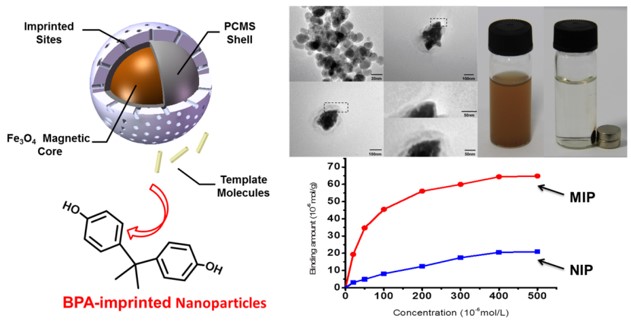Molecularly imprinted polymer (MIP), an artificial recognition material with high affinity and selectivity to the template molecule, has attracted more and more attention in the fields of chromatography, artificial antibodies, chemical sensors, and drug delivery.
To address challenging problems of molecularly imprinted technology such as imprinting biological macromolecules, template leakage, low binding efficiency, and incompatibility with aqueous media, Prof. Rui ZHAO’s group in CAS Key Laboratory of Analytical Chemistry for Living Biosystems has devoted to the design and fabrication of new molecularly imprinted materials for highly selective analysis.
A pseudo template molecularly imprinted polymer was prepared for a prototype folate antagonist cytotoxic drug methotrexate (MTX) and a RP-HPLC method combined with the MIP was developed for the determination of MTX in human serum. Because of the poor solubility of MTX in common MIP preparation solvents, trimethoprim (TMP), a molecule having the similar imprinting sites as MTX, is selected as the pseudo template (Figure 1). Chromatographic behaviors indicated that the TMP-MIP possessed excellent affinity and selectivity for MTX. And the imprinting factor for MTX was high up to 9.5. Moreover, TMP-MIP was used as the solid-phase extraction (SPE) material to enrich MTX in human serum samples. The results indicated that the pseudo template MIP can be applied to preconcentration, purification and analysis of MTX in clinic samples (J. Chromatogr. A 2009, 1216, 7533).

Figure 1 Molecular structures of TMP, MTX and schematics of imprinting procedures.
Considering that magnetic particles can be easily collected and isolated by an external magnetic field, the research team recently focuses on the fabrication of surface imprinted nano-scale MIP with magnetic properties. The superparamagnetic surface molecularly imprinted Fe3O4@MIP nanoparticles for bisphenol A (BPA) were prepared via surface initiated atom transfer radical polymerization (si-ATRP) (Figure 2). The BPA imprinted Fe3O4@MIP revealed specific selectivity and high affinity to the template BPA over structural analogues. Thanks to the surface-imprinted approach, these MIP nanoparticles showed good site accessibility for BPA. Fe3O4@MIP was used to determine BPA in real samples with good accuracy and precision (J. Mater. Chem. 2011, 21, 9232). Considering the severe problem in preparing water compatible MIPs, novel superparamagnetic surface molecularly imprinted Fe3O4@MIP nanoparticles were developed for water-soluble pefloxacin mesylate (PEF-M) via si-ATRP. The Fe3O4@MIP nanoparticles possessed specific recognition and high affinity towards template PEF-M in aqueous media. The high saturation magnetization of Fe3O4@MIP led to the fast separation. Furthermore, Fe3O4@MIP nanoparticles were directly used to selectively enrich PEF-M from real samples (J. Chromatogr. A 2012, 1246, 15).

Figure 2 A novel superparamagnetic molecularly imprinted Fe3O4@MIP nanoparticle for the highly-selective analysis of bisphenol A.
